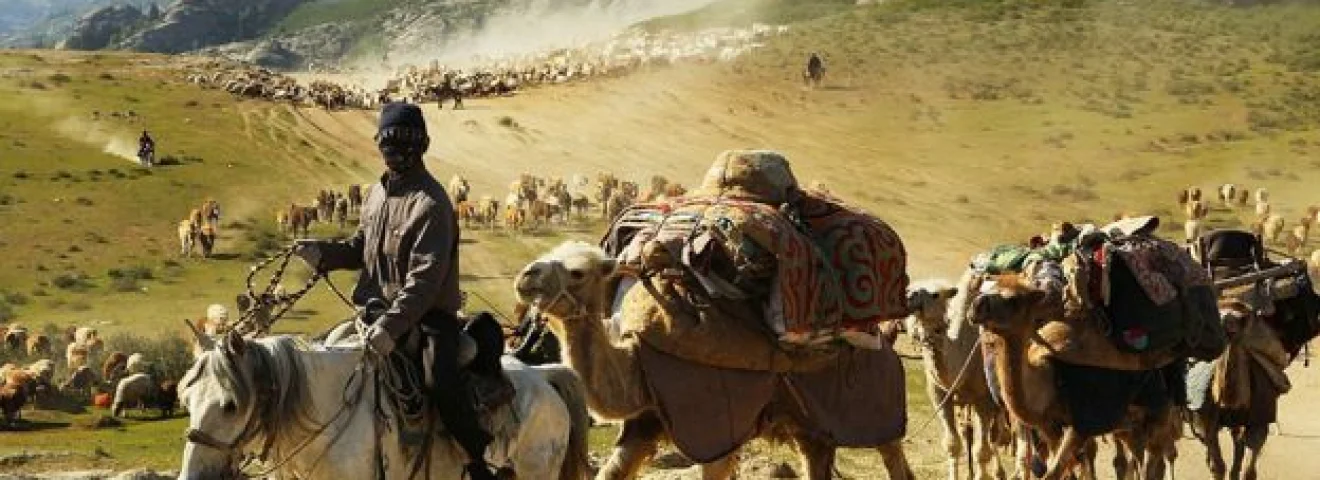Globalnews.kz hereby post the exposition of an article published by Andrew Lawler in the Science Magazine.
In the venerable halls of the Mesopotamian city of Mari, nearly four millennia past, King Zimri-Lim stirred from a slumber troubled by a harrowing vision. In his nocturnal tumult, nomads from the encompassing desert had ensnared his cherished consort. Scholars have long pondered whether Zimri-Lim’s dread, as chronicled in ancient cuneiform, mirrored the paramount role these peripatetic marauders assumed in the dawn of urban civilization. These wanderers, whose presence vexed even sovereigns in their repose, were begrudgingly acknowledged for ferrying rare commodities from realms afar. Roaming vast expanses in pursuit of verdant pastures, these pastoralists are postulated as the pioneering architects of the nascent trade networks that kindled the emergence of the world’s inaugural civilization circa 3000 B.C.E. in the land now known as Iraq.
Historically, the ephemeral footprints of these ancient wanderers have eluded scholars, compelling reliance on comparative studies of 20th-century Middle Eastern nomads to sketch their portraits. Yet, modern archaeologists, armed with innovative methodologies, are deciphering the subtle vestiges left by these ancient pastoralists. Empirical data gleaned from animal excrement, osseous remains, dental calculus, and botanical vestiges posit that these herders predominantly tended to the requisites of specific urban enclaves rather than embarking on intercity migrations. Emily Hammer, an esteemed archaeologist from the University of Pennsylvania, contends that their journeys were not the extensive treks once believed, thus challenging their role as the natural conduits of trade.
This contention, which Hammer, alongside Ben Arbuckle of the University of North Carolina at Chapel Hill, delineates in an anticipated publication in the Journal of Archaeological Science, has ignited fervent discourse regarding the mechanisms that nurtured early urban prosperity. Abbas Alizadeh of the University of Chicago in Illinois, with decades devoted to studying pastoralists like the Bakhtiari of southwest Iran, dismisses their hypothesis with a skeptic’s scorn.
The chronicle of pastoralism is intertwined with the advent of agriculture in the Near East some 10,000 years prior. The temporal nexus when these nomads commenced their extensive peregrinations in search of seasonal sustenance remains a topic of scholarly contention. Alizadeh, alongside luminaries like Frank Hole of Yale University, proposes that as early as 7000 B.C.E., pastoralists in the fringes of Mesopotamia embarked on substantial migrations, an inference drawn from the patterns of contemporary pastoralists and archaeological excavations of transient settlements and sepulchers.
With the rise of the first city-states, a cornucopia of precious stones, metals, and timber from distant lands like Afghanistan, Iran, and Anatolia flowed into southern Mesopotamia. By 2000 B.C.E., a sophisticated trading framework distributed resources from regions as remote as the Indus civilization to the Levant, buoying the affluence of city-states like Ur. While nomadic herders were traditionally envisioned as pivotal in this process, scant early records elucidate the identities of these early merchants. “Trade remains almost textually invisible,” laments Piotr Michalowski, a cuneiform savant from the University of Michigan in Ann Arbor.
Innovations in analytical techniques now intimate that prior to 1000 B.C.E., pastoralists in regions like Jordan, Syria, Turkey, and Iran remained proximal to their homesteads, unlikely to have served as global intermediaries. For instance, Cheryl Makarewicz, an archaeozoologist from Germany’s University of Kiel, discerned through isotopic analysis that the ruminants of a site in Amman, dating to circa 7000 B.C.E., grazed locally rather than in distant meadows. Similar findings at Çatalhöyük in eastern Turkey suggest a predominantly sedentary existence for these animals.
As urbanity burgeoned, Hammer, Arbuckle, and Dan Potts of New York University argue that pastoralists fulfilled the urban demand for meat, milk, and wool while remaining on the peripheries. If nomads were not the heralds of long-distance trade in antiquity, then goods likely traversed through alternate conduits, possibly sustained by social networks forged through royal alliances and itinerant traders, as Potts suggests.
Evidence from the Bronze Age Middle East indicates a more densely populated landscape than previously assumed, implying a vibrant network of cities and towns facilitating trade. Texts from around 1900 B.C.E. in the Anatolian town of Kanesh describe merchant families orchestrating extensive donkey caravans to Assur, a city south of contemporary Mosul in Iraq. Michalowski concurs that trade was predominantly a civilian enterprise, rendering the role of mobile pastoralists in this narrative less central.
The emergence of domesticated dromedary camels in the first millennium B.C.E. marks a period when nomads commenced their extensive seasonal migrations, according to Hammer, Arbuckle, and Potts. Yet, many scholars remain skeptical of this revised paradigm. Guillermo Algaze of the University of California, San Diego, and Steve Rosen of Ben-Gurion University in Israel continue to champion the traditional view of mobile pastoralists as integral to early trade networks.
As new findings emerge, such as data from renewed excavations at Ur where Hammer has recently worked, the debate may inch closer to resolution. The question of whether marauding nomads or local miscreants incited Zimri-Lim’s nocturnal terror might soon be unraveled, shedding light on the intricate tapestry of our collective past.









